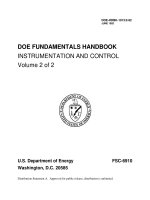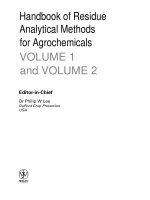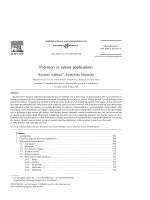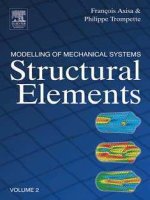Fluorinated polymers volume 2 applications polymer chemistry series
Bạn đang xem bản rút gọn của tài liệu. Xem và tải ngay bản đầy đủ của tài liệu tại đây (14.25 MB, 397 trang )
Fluorinated Polymers
Volume 2: Applications
RSC Polymer Chemistry Series
Editor-in-Chief:
Professor Ben Zhong Tang, The Hong Kong University of Science and
Technology, Hong Kong, China
Series Editors:
Professor Alaa S. Abd-El-Aziz, University of Prince Edward Island, Canada
Professor Stephen Craig, Duke University, USA
Professor Jianhua Dong, National Natural Science Foundation of China, China
Professor Toshio Masuda, Shanghai University, China
Professor Christoph Weder, University of Fribourg, Switzerland
Titles in the Series:
1: Renewable Resources for Functional Polymers and Biomaterials
2: Molecular Design and Applications of Photofunctional
Polymers and Materials
3: Functional Polymers for Nanomedicine
4: Fundamentals of Controlled/Living Radical Polymerization
5: Healable Polymer Systems
6: Thiol-X Chemistries in Polymer and Materials Science
7: Natural Rubber Materials: Volume 1: Blends and IPNs
8: Natural Rubber Materials: Volume 2: Composites and Nanocomposites
9: Conjugated Polymers: A Practical Guide to Synthesis
10: Polymeric Materials with Antimicrobial Activity: From Synthesis to
Applications
11: Phosphorus-Based Polymers: From Synthesis to Applications
12: Poly(lactic acid) Science and Technology: Processing, Properties,
Additives and Applications
13: Cationic Polymers in Regenerative Medicine
14: Electrospinning: Principles, Practice and Possibilities
15: Glycopolymer Code: Synthesis of Glycopolymers and their Applications
16: Hyperbranched Polymers: Macromolecules in-between Deterministic
Linear Chains and Dendrimer Structures
17: Polymer Photovoltaics: Materials, Physics, and Device Engineering
18: Electrical Memory Materials and Devices
19: Nitroxide Mediated Polymerization: From Fundamentals to
Applications in Materials Science
20:
21:
22:
23:
Polymers for Personal Care Products and Cosmetics
Semiconducting Polymers: Controlled Synthesis and Microstructure
Bio-inspired Polymers
Fluorinated Polymers: Volume 1: Synthesis, Properties, Processing and
Simulation
24: Fluorinated Polymers: Volume 2: Applications
How to obtain future titles on publication:
A standing order plan is available for this series. A standing order will bring
delivery of each new volume immediately on publication.
For further information please contact:
Book Sales Department, Royal Society of Chemistry, Thomas Graham House,
Science Park, Milton Road, Cambridge, CB4 0WF, UK
Telephone: þ44 (0)1223 420066, Fax: þ44 (0)1223 420247
Email:
Visit our website at www.rsc.org/books
Fluorinated Polymers
Volume 2: Applications
Edited by
Bruno Ameduri
Ecole Nationale Supe´rieure de Chimie de Montpellier, Montpellier, France
Email:
and
Hideo Sawada
Hirosaki University, Hirosaki, Japan
Email:
RSC Polymer Chemistry Series No. 24
Print ISBN: 978-1-78262-916-0
PDF eISBN: 978-1-78262-936-8
EPUB eISBN: 978-1-78262-937-5
Two-volume set print ISBN: 978-1-78262-917-7
ISSN: 2044-0790
A catalogue record for this book is available from the British Library
r The Royal Society of Chemistry 2017
All rights reserved
Apart from fair dealing for the purposes of research for non-commercial purposes or for
private study, criticism or review, as permitted under the Copyright, Designs and Patents
Act 1988 and the Copyright and Related Rights Regulations 2003, this publication may not
be reproduced, stored or transmitted, in any form or by any means, without the prior
permission in writing of The Royal Society of Chemistry, or in the case of reproduction
in accordance with the terms of licences issued by the Copyright Licensing Agency in
the UK, or in accordance with the terms of the licences issued by the appropriate
Reproduction Rights Organization outside the UK. Enquiries concerning reproduction
outside the terms stated here should be sent to The Royal Society of Chemistry at the
address printed on this page.
The RSC is not responsible for individual opinions expressed in this work.
The authors have sought to locate owners of all reproduced material not in their own
possession and trust that no copyrights have been inadvertently infringed.
Published by The Royal Society of Chemistry,
Thomas Graham House, Science Park, Milton Road,
Cambridge CB4 0WF, UK
Registered Charity Number 207890
For further information see our web site at www.rsc.org
Printed in the United Kingdom by CPI Group (UK) Ltd, Croydon, CR0 4YY, UK
Preface
Because of the increasing need for better performing materials endowed
with specific properties for high-tech applications, fluoropolymers have
undergone a rapid development. Since their discovery in the 1930s, these
niche specialty polymers have been regarded as unique macromolecules
with an exceptional combination of characteristics (derived from the strong
C–F bond, such as chemical resistance, heat and light stability, electrical
insulation and liquid and soil repellency) to provide superior performance in
the chemical, medical, aerospace, automotive, electrical and electronics
industries.
The relationship between the structures of the monomers and the properties of the resulting (co)polymers is of increasing interest in order to tune
these properties towards the most appropriate applications.
These fluoroplastics or fluoroelastomers have already been involved in
many applications, ranging from surfactants, optical fibers, biomaterials,
liners or ultrathin layers, electronics, seals and O-rings for the aerospace
and automotive industries, coatings, piezoelectric devices, electrolytes and
separators for lithium ion batteries and back-sheets for photovoltaics to
membranes for seawater desalination and fuel cells. These polymers are
nowadays experiencing enormous growth and their production is increasing
by 7% yearly. In the last decade, around 10 reviews, chapters and books have
been published that witness the great interest in these materials.
Fluorinated Polymers is composed of two volumes and includes 23 chapters
written by internationally recognized industrial and academic experts,
outlining fundamental concepts and applied topics, starting with a general
introduction. Then, emphasis is placed on recent developments and
challenges, and most chapters describe comprehensive techniques of
synthesis, characterization and properties of fluoropolymers (FPs). Volume 1
is devoted to the basic aspects of FPs, including the chemistry, synthesis of
RSC Polymer Chemistry Series No. 24
Fluorinated Polymers: Volume 2: Applications
Edited by Bruno Ameduri and Hideo Sawada
r The Royal Society of Chemistry 2017
Published by the Royal Society of Chemistry, www.rsc.org
vii
viii
Preface
key reactants and techniques of polymerization, processing, and simulation,
while Volume 2 concerns specific characterization and applications.
Regarding syntheses, those of initiators (especially peroxides, Chapter 1,
Volume 1), monomers (Chapter 2, Volume 1), oligomers (Chapter 4, Volume
1), well-defined fluorotelomers (Chapter 11, Volume 1 and Chapter 1,
Volume 2) and alternating copolymers (Chapters 9 and 10, Volume 2), are
highlighted, in addition to fluoroplastics and fluoroelastomers (Chapters 3
and 4, Volume 2) and key (co)polymers such as polyacrylates (Chapter 8,
Volume 1 and Chapters 1 and 2, Volume 2), polyaromatics (Chapter 5,
Volume 1), PVDF (Chapter 6, Volume 2), polyphosphazenes (Chapter 3,
Volume 2), perfluoropolyethers (Chapters 5 and 7, Volume 2), copolymers
and terpolymers based on vinylidene fluoride (Chapter 7, Volume 1 and
Chapter 6, Volume 2), tetrafluoroethylene (Chapter 9, Volume 2), or
chlorotrifluoroethylene (Chapters 5 and 10, Volume 2). In addition, common
synthetic methods such as anionic polymerization (Chapter 3, Volume 1)
and radical polymerization in supercritical CO2 (Chapter 7, Volume 1) and
specific processes such as electrochemical (Chapter 6, Volume 1) and melt
processing (Chapter 10, Volume 1) complete these aspects, while Chapter 11,
Volume 1 brings an insight into simulation.
This book also outlines some characterizations of FPs such as the surface
properties of poly(acrylate)s (Chapter 8, Volume 1 and Chapters 1 and 2,
Volume 2), self-assembly of well-architectured FPs (Chapter 9, Volume 1) and
their applications in paints and coatings (Chapters 5 and 6, Volume 2),
energy storage and conversion (Chapter 5, Volume 1 and Chapters 7, 8 and 9,
Volume 2) and nanomaterials for specific applications (Chapters 11 and 12,
Volume 2). In addition, environmental aspects (Chapters 1 and 2, Volume 2)
are also supplied.
We would like to thank all contributors for their valuable chapters
listed above.
These volumes, for immediate use by today’s engineers and industrial and
academic scientists and researchers, and also for graduate students, working
in the fields of materials science, polymer chemistry and energy applications
of polymers have been arranged to facilitate self-managed reading and
learning. They are both a source of data and a reference.
Bruno Ameduri
Hideo Sawada
Contents
Volume 1
SYNTHESIS
Chapter 1 Fluorinated Peroxides as Initiators of Fluorinated
Polymers
Shohei Yamazaki and Hideo Sawada
1.1
1.2
1.3
Introduction
Computational Methods
Results and Discussion
1.3.1 Molecular Structure of
Alkanoyl/Fluoroalkanoyl Peroxides
1.3.2 Molecular Structure of
Alkanoyl/Fluoroalkanoyl Radicals
1.3.3 Bond Dissociation Energy of Alkanoyl/
Fluoroalkanoyl Peroxides and Radicals
1.3.4 Thermal Decomposition of
Alkanoyl/Fluoroalkanoyl Peroxides
1.4 Conclusion
Acknowledgements
References
Chapter 2
3
3
5
6
7
10
12
17
20
21
21
Fluoroalkylated Styrene Dimers: Synthesis, Properties, and
Applications
Masato Yoshida
22
2.1
22
Introduction
RSC Polymer Chemistry Series No. 24
Fluorinated Polymers: Volume 2: Applications
Edited by Bruno Ameduri and Hideo Sawada
r The Royal Society of Chemistry 2017
Published by the Royal Society of Chemistry, www.rsc.org
ix
x
Contents
2.2
General Aspects of the Addition of Perfluoroalkyl
Radicals to Olefinic Compounds
2.3 Process for the Formation of Head-to-head Type
Styrene Dimers Bearing Two Fluoroalkyl
End-groups, as a Basic Principle for Reactions
Between Two Radicals
2.4 Synthesis and Characteristic Properties of Styrene
Dimers, as the Smallest Model Unit for Fluoroalkyl
End-capped Oligomers and Polymers
2.5 Conclusion
Acknowledgements
References
Chapter 3 Anionic Polymerization of Fluorinated Vinyl Monomers
Tadashi Narita
3.1
3.2
Introduction
Anionic Polymerization Reactivity of Fluorinated
Acrylates and Methacrylates
3.3 Anionic Polymerization Reactivity of Fluorinated
1,3-Butadiene
3.4 Anionic Polymerization Reactivity of Fluorinated
Styrenes
3.5 Conclusion
References
Chapter 4 Polyaddition of Fluorinated Vinyl Monomers
Tadashi Narita
4.1 Introduction
4.2 Anionic Polyaddition of Fluorinated Vinyl Monomers
4.3 Radical Polyaddition of Fluorinated Vinyl Monomers
4.4 Conclusion
References
Chapter 5 Semifluorinated Aromatic Polymers and
Their Properties
Susanta Banerjee and Anindita Ghosh
5.1
5.2
General Introduction to Aromatic Fluorinated
Polymers
Fluorinated Poly(Arylene Ether)s
5.2.1 Preparation of Fluorinated
Poly(Arylene Ether)s
23
25
29
37
37
37
40
40
43
53
67
69
70
72
72
73
79
101
101
103
103
104
105
Contents
xi
5.2.2
Properties of Fluorinated
Poly(Arylene Ether)s
5.2.3 Fluorinated Poly(Arylene Ether)s for
Membrane-based Applications
5.3 Fluorinated Poly(Ether Imide)s
5.3.1 Preparation of Fluorinated
Poly(Ether Imide)s
5.3.2 Properties of Fluorinated
Poly(Ether Imide)s
5.3.3 Fluorinated Poly(Ether Imide)s for
Membrane-based Applications
5.4 Fluorinated Poly(Ether Amide)s
5.4.1 Preparation of Fluorinated Poly(Ether
Amide)s
5.4.2 Properties of Fluorinated
Poly(Ether Amide)s
5.4.3 Fluorinated Poly(Ether Amide)s for
Membrane-based Applications
5.5 Fluorinated Polyazoles
5.5.1 Preparation of Fluorinated
Poly(Benzimidazole)s
5.5.2 Preparation of Fluorinated
Poly(Benzoxazole)s
5.6 Miscellaneous Aromatic Fluorinated
Polymers
5.6.1 Fluorinated Poly(Arylene)s
5.6.2 Fluorinated Hyperbranched Polymers
5.6.3 Fluorinated Dendrimers
5.6.4 Fluorinated Acrylate Polymers
5.6.5 Fluorinated Polymers with
Perfluorocyclobutyl (PFCB) Units
5.6.6 Fluorinated Polymers with
Octafluorocyclopentene Units
5.6.7 Fluorinated Phosphorus-containing
Polymers
5.6.8 Fluorinated Microporous Copolymer as
Gas Separation Membrane
5.6.9 Quaternized Fluorinated Copolymers as
Anion-conductive Membranes
5.6.10 ETFE Film Grafted with Pentafluorostyrene
as a Protein-exchange Membrane
5.7 Conclusion
Abbreviations
References
108
111
122
124
125
133
141
141
141
146
153
153
158
163
163
163
168
168
168
175
175
175
177
178
181
182
183
xii
Contents
Chapter 6 Synthesis of Fluoro-functional Conjugated Polymers by
Electrochemical Methods
Shinsuke Inagi
6.1
6.2
Introduction
Electropolymerization of Fluoro-aromatic
Compounds
6.2.1 Electropolymerization of Aromatic Monomers
6.2.2 Electropolymerization of Fluoro-aromatic
Monomers
6.2.3 Surface Morphology and Properties of
Fluoro-functionalized Conjugated Polymers
6.2.4 Fluoro-functionalized Conjugated Polymers
for Electronic Materials
6.3 Electrochemical Fluorination of Conjugated
Polymers
6.3.1 Electrochemical Polymer Reactions
6.3.2 Anodic Fluorination of Polyfluorene Derivatives
6.3.3 Fluorination of Polyaniline by the CRS
Method
6.4 Surface Modification of Conjugated Polymers with
Fluoro-functional Groups by Electrochemical
Methods
6.4.1 Conjugated Polymer Surface
6.4.2 Electro-click Reaction on Conjugated
Polymer Surfaces
6.4.3 Gradient Surface Modification by the
Electro-click Method
6.5 Conclusion
References
Chapter 7 Supercritical Carbon Dioxide as Reaction Medium for
Fluoropolymer Synthesis and Kinetic Investigations into
Radical Polymerizations of VDF and HFP
Benjamin Hosemann, Rebekka Siegmann and
Sabine Beuermann
7.1
7.2
7.3
Introduction
Supercritical Carbon Dioxide as Reaction Medium
for Fluoropolymer Synthesis
In-line Monitoring of Vinylidene Fluoride
Homo- and Copolymerizations in the Homogeneous
Phase with Supercritical Carbon Dioxide
190
190
191
191
193
194
196
197
197
198
201
202
202
202
204
206
207
211
211
214
215
Contents
xiii
7.4
Kinetic Investigations for Vinylidene Fluoride
Homo- and Copolymerizations in Supercritical
Carbon Dioxide
7.4.1 Initiator Decomposition Kinetics
7.4.2 Propagation Rate Coefficients for VDF
Homo- and Copolymerizations
7.4.3 Termination Kinetics of VDF–HFP
copolymerizations
References
216
217
219
225
229
PROPERTIES
Chapter 8 Structure–Property Relations in Semifluorinated
Polymethacrylates
D. Pospiech, D. Jehnichen, P. Chunsod, P. Friedel,
F. Simon and K. Grundke
8.1
8.2
Introduction
Experimental
8.2.1 Materials
8.2.2 Polymer Synthesis
8.2.3 Preparation of Thin Films
8.2.4 Characterization
8.2.5 Simulations
8.3 Results and Discussion
8.3.1 Synthesis Results
8.3.2 Solid-state Structure
8.3.3 Simulation Results
8.3.4 Temperature Behavior
8.4 Surface Properties
8.4.1 Surface Structure as Investigated by XRR
and GISAXS
8.4.2 Surface Composition
8.4.3 Wetting Behavior
8.5 Conclusion
Acknowledgements
References
Chapter 9 Preparation and Self-assembly of Amphiphilic
Fluoropolymers
Chun Feng and Xiaoyu Huang
9.1
9.2
Introduction
Preparation and Self-assembly of Linear
Fluoropolymers
235
235
239
239
239
240
241
244
245
245
246
248
250
254
254
256
261
269
270
270
276
276
278
xiv
Contents
9.3
Preparation and Self-assembly of Non-linear
Fluoropolymers
9.4 Conclusion
Acknowledgements
References
292
301
303
303
PROCESSING
Chapter 10 The Melt Viscosity Properties of Fluoroplastics –
Correlations to Molecular Structure and Tailoring
Principles
Harald Kaspar
10.1
10.2
10.3
Introduction
Terpolymers Under Investigation
Fundamentals of Melt Rheology
10.3.1 Fluoropolymer Melts in Shear Flows
10.3.2 Superposition Principles
10.4 Determining Molar Masses
10.4.1 General Considerations on the Molar
Mass Distribution
10.4.2 Key Rheology Parameters and Dependence
on the Average Molar Mass
10.4.3 Diagnosing the Molar Mass Distribution
of Insoluble Polymers
10.5 Customizing Concepts for Linear Chains
10.5.1 Controlling the Average Molar Mass
10.5.2 End-group Considerations in View of
Chain Transfer
10.5.3 Fine Tuning the Molar Mass Distribution
10.6 Tailoring the Polymer Topology by Long-chain
Branching
10.6.1 Evolution from Primary to Higher Order
Populations
10.6.2 Qualifying Complex Chain Architectures
10.6.3 Long-chain Branched Fluoropolymers in
Elongational Flows
10.6.4 Benefits in Melt Processing
10.7 Conclusion
Abbreviations and Symbols
Abbreviations
Symbols
References
309
309
312
314
314
317
320
320
321
325
329
329
331
332
335
335
339
343
348
351
353
353
354
356
Contents
xv
SIMULATION
Chapter 11 Molecular Simulation of Fluorinated Telomer and Polymers 361
´tienne Cuierrier, Alexandre Fleury,
François Porzio, E
Bruno Ame´duri and Armand Soldera
11.1
11.2
Introduction
Theory
11.2.1 Arrhenius Equation
11.2.2 Transition-state Theory
11.3 Quantum Chemistry
¨dinger Equation
11.3.1 Resolving the Schro
11.3.2 Errors
11.4 Application
11.4.1 Context
11.4.2 The Molecular Structure
11.4.3 The Symmetry Factor s
11.4.4 The TS Quasi-partition Function
11.4.5 The Free Reactant Partition Function per
Unit Volume
11.4.6 The Activation Energy Ea
11.4.7 The Rate Constants and the Chain
Transfer Constant
11.4.8 Intrinsic Reaction Coordinates (IRCs)
11.4.9 Perspectives: Study of Regioselectivity for
Iodine Transfer Polymerization
11.5 Conclusion
References
Subject Index
361
363
363
364
368
368
370
374
374
375
377
378
378
379
380
380
381
382
383
386
Volume 2
APPLICATIONS
Chapter 1 Industrial Aspects of Fluorinated Oligomers
and Polymers
Rudy Dams and Klaus Hintzer
1.1
1.2
Introduction
Fluorinated Monomers and Building Blocks
1.2.1 Fluorinated Monomers
1.2.2 Perfluoroalkyl Building Blocks
3
3
4
4
7
xvi
Contents
1.3
Functionalized Oligomers and Their Applications
1.3.1 Synthesis
1.3.2 Derivatives of Functional Oligomers and
Their Applications
1.4 Overview of Fluoropolymers
1.4.1 Fluoropolymer Production and
Applications
1.4.2 Fluoropolymers with Functional Groups
1.4.3 Applications
1.5 Environmental Aspects
1.5.1 C8 Phase-out and Replacements
1.5.2 Fluoropolymer Recycling
1.5.3 Summary
Abbreviations
Monomers/Fluorochemicals
Polymers
References
Chapter 2 Fluoroalkyl Acrylate Polymers and Their Applications
Ikuo Yamamoto
2.1
2.2
2.3
2.4
2.5
2.6
Introduction
The PFOA Issue
Preparation
2.3.1 Monomers
2.3.2 Polymerizations
2.3.3 Polymer Composition
Expression Mechanism of Water Repellency of
Fluoroalkyl Acrylate Polymers
2.4.1 Dynamic Contact Angle
2.4.2 Thermal Analysis
2.4.3 Molecular Aggregation States
2.4.4 Surface Reorganization
Molecular Design Concept for Short-chain
Fluoroalkyl Acrylate Polymers
2.5.1 Comonomer
2.5.2 a-Substituent Group
2.5.3 Spacer
2.5.4 Perfluoroalkyl (Rf) Group
Applications
2.6.1 Textiles
2.6.2 Carpets
9
9
11
15
15
17
18
18
18
21
25
26
26
27
27
32
32
33
34
34
35
35
36
37
38
38
40
41
42
43
45
45
45
45
48
Contents
xvii
2.6.3 Paper
2.6.4 Non-woven Materials
2.6.5 Coatings
2.7 Outlook
Acknowledgements
References
Chapter 3 Structural Diversity in Fluorinated Polyphosphazenes:
Exploring the Change from Crystalline Thermoplastics to
High-performance Elastomers and Other New Materials
Harry R. Allcock
3.1
3.2
3.3
Introduction
Synthesis Routes
Semicrystalline Versus Elastomeric or Gum-type
Polyphosphazenes
3.4 Specific Fluoro-organophosphazenes
3.4.1 Poly[bis(trifluoroethoxy)phosphazene]
(Compound 2)
3.4.2 Polymers with Longer Telomer Side-chains
of Type –OCH2(CF2)xCF2H
3.4.3 Fluoroalkoxy Side-groups with CF3
Terminal Units
3.4.4 Fluoroalkoxy Side-groups of the
Type –OCH2CH2(CF2)xCF3
3.4.5 Fluoroaryloxyphosphazenes
3.4.6 Trifluoroethylamino Side-groups
3.5 Mixed-substituent Elastomeric
Polyphosphazenes
3.6 Interpenetrating Polymer Networks from PN-F and
[NP(OCH2CF3)2]n
3.7 Elastomers Based on Non-covalent Interchain
Interactions
3.8 Hybrid Fluoro-organophosphazene–Organosilicon
Polymers
3.9 Fibers, Films and Surfaces from Polymer 2
3.10 Fire Resistance
3.11 Optical Properties: Controlled Refractive Index
Polymers and Polymeric Dyes
3.12 Amphiphilic Polymer Membranes
3.13 Prospects for the Future
References
48
48
49
49
49
50
54
54
55
59
60
60
60
61
62
62
63
63
65
66
69
72
73
73
73
76
77
xviii
Contents
Chapter 4 Fluoroplastics and Fluoroelastomers – Basic Chemistry
and High-performance Applications
Masahiro Ohkura and Yoshitomi Morizawa
Properties of Fluorine and Brief History of
Fluoropolymers
4.2 Perfluoroplastics
4.2.1 Polytetrafluoroethylene (PTFE)
4.2.2 Tetrafluoroethylene–Hexafluoropropylene
Copolymer (FEP)
4.2.3 Perfluoroalkoxy Copolymer (PFA)
4.2.4 Amorphous Perfluoroplastics
4.3 Partially Fluorinated Plastics
4.3.1 Poly(Chlorotrifluoroethylene) (PCTFE)
4.3.2 Poly(Vinylidene Fluoride) (PVdF)
4.3.3 Poly(Vinyl Fluoride) (PVF)
4.3.4 Ethylene–Tetrafluoroethylene Copolymer
(ETFE)
4.3.5 Other Fluorine-containing Plastics
4.4 Fluoroelastomers
4.4.1 Vinylidene Fluoride Copolymer (FKM)
4.4.2 Tetrafluoroethylene–Propylene Copolymer
(FEPM)
4.4.3 Perfluoroelastomer (FFKM)
4.4.4 Other Fluoroelastomers
4.5 Conclusion
References
80
4.1
Chapter 5
80
83
85
87
88
90
93
95
95
96
96
97
97
98
100
100
101
103
103
Fluorinated Specialty Chemicals – Fluorinated Copolymers
for Paints and Perfluoropolyethers for Coatings
110
Taiki Hoshino and Yoshitomi Morizawa
5.1
Synthesis and Coating Application of Partially
Fluorinated Polymers
5.1.1 What Are Partially Fluorinated Polymers for
Coatings?
5.1.2 Types and Characteristics of Partially
Fluorinated Polymers for Coatings
5.1.3 Manufacturing Process for Partially
Fluorinated Polymers
5.1.4 Examples of Coating Applications of Partially
Fluorinated Polymers
110
111
112
117
118
Contents
xix
5.2
Synthesis and Application of Perfluoropolyethers
5.2.1 What Are Perfluoropolyethers?
5.2.2 Types and Characteristics of
Perfluoropolyethers
5.2.3 Manufacturing Process for
Perfluoropolyethers
5.2.4 Examples of Applications of
Perfluoropolyethers
References
Chapter 6 Commercial Synthesis and Applications of
Poly(Vinylidene Fluoride)
James T. Goldbach, Ramin Amin-Sanayei, Wensheng He,
James Henry, Walt Kosar, Amy Lefebvre, Gregory O’Brien,
Diane Vaessen, Kurt Wood and Saeid Zerafati
6.1
Commercial Synthesis of PVDF
6.1.1 Properties of Vinylidene Fluoride
6.1.2 VDF Polymerization
6.1.3 Some Typical Polymerization
Conditions
6.2 Industrial Applications of
Poly(Vinylidene Fluoride)
6.2.1 History and Context
6.2.2 Key Properties of PVDF
6.2.3 Property Comparisons with Other
Fluoropolymers
6.2.4 PVDF Producers
6.2.5 Chemical Process Industry (CPI)
Applications
6.2.6 Wire and Cable Applications
6.2.7 Petrochemical Applications
6.2.8 PVDF Resins for Porous Membranes
6.2.9 PVDF in Photovoltaic Applications
6.2.10 PVDF in Lithium Ion Battery
Applications
6.3 PVDF in Coatings Applications
6.3.1 Introduction
6.3.2 Types of PVDF Coatings
6.3.3 Performance of PVDF-based Coatings
6.4 Conclusion
References
119
119
120
121
124
126
127
127
127
128
129
131
131
132
133
134
134
135
137
139
140
141
145
145
146
151
153
154
xx
Contents
Chapter 7 The Role of Perfluoropolyethers in the Development of
Polymeric Proton Exchange Membrane Fuel Cells
M. Sansotera, M. Gola, G. Dotelli and W. Navarrini
7.1
7.2
Introduction
Interaction of PFPE Chains on Carbonaceous
Materials
7.3 Effects of PFPE on Carbon Black and Carbon Fibers
7.3.1 PFPEs on Carbon Black
7.3.2 Effects of PFPE on Carbon Fibers
7.4 Effects of PFPE in PEMFC Gas Diffusion Layers
7.4.1 Macroporous Layer
7.4.2 Microporous Layer
References
158
158
161
163
163
166
168
168
172
175
Chapter 8 Fluorinated Ionomers and Ionomer Membranes: Monomer
and Polymer Synthesis and Applications
179
Takeshi Hirai and Yoshitomi Morizawa
8.1
Introduction and Brief History of Fluorinated
Ionomer Membranes
8.2 Synthesis of Representative Ionomer Membranes
8.2.1 Sulfonic Acid-type Monomers
8.2.2 Carboxylic Acid-type Monomers
8.2.3 Polymerization
8.2.4 Hydrolysis, Cation Exchange and Fabrication
8.3 Development of Ionomer Functions in PEFC
Applications
8.3.1 Fundamentals of PEFCs
8.3.2 Applications and Performance Requirements
for Ionomers
8.3.3 Proton Exchange Membranes
8.3.4 Ionomers for Electrodes
8.4 Conclusion
References
179
181
181
181
183
186
187
187
191
192
202
203
204
Chapter 9 Research and Non-major Commercial Co- and Terpolymers
of Tetrafluoroethylene
206
Daniel A. Hercules, Cameron A. Parrish and
Joseph S. Thrasher
9.1
Introduction and Scope
206
Contents
xxi
9.2
Co- and Terpolymers of Tetrafluoroethylene and
Vinyl Ethers
9.2.1 Co- and Terpolymers of Tetrafluoroethylene
and Alkyl Vinyl Ethers
9.2.2 Co- and Terpolymers of Tetrafluoroethylene
and Alkyl Trifluorovinyl Ethers
9.2.3 Co- and Terpolymers of Tetrafluoroethylene
and Perfluoroalkyl Trifluorovinyl Ethers
9.2.4 Co- and Terpolymers of Tetrafluoroethylene
and Fluorinated Alkyl Vinyl Ethers Having
Other Halogen Functionalities
9.2.5 Co- and Terpolymers of Tetrafluoroethylene
and Fluorinated Alkyl Vinyl Ethers
Having Multiple Ether Linkages on the
Side-chain
9.2.6 Co- and Terpolymers of Tetrafluoroethylene
and Fluorinated Alkyl Vinyl Ethers Having
Sulfonyl Functionalities
9.2.7 Co- and Terpolymers of Tetrafluoroethylene
and Fluorinated Alkyl Vinyl Ethers Having
Amide Functionalities
9.2.8 Co- and Terpolymers of Tetrafluoroethylene
and Fluorinated Alkyl Vinyl Ethers Having
Carbonyl Functionalities
9.2.9 Co- and Terpolymers of Tetrafluoroethylene
and Fluorinated Alkyl Vinyl Ethers Having
Nitrile Functionalities (e.g. 8-CNVE)
9.2.10 Co- and Terpolymers of Tetrafluoroethylene
and Fluorinated Alkyl Vinyl Ethers
Having Multiple Vinyl Ether
Functionalities
9.3 Co- and Terpolymers of Tetrafluoroethylene and
Non-fluorine-containing Alkenes
9.4 Co- and Terpolymers of Tetrafluoroethylene and
Polyfluoroalkenes
9.5 Co- and Terpolymers of Tetrafluoroethylene and
Perfluoroalkenes
9.6 Co- and Terpolymers of Tetrafluoroethylene with
Cyclic Monomers and Tetrafluoroethylene-based
Photoresist Materials
9.7 Future Work and Conclusions
References
209
209
215
217
218
219
220
221
223
224
226
228
233
242
245
253
254
xxii
Contents
Chapter 10 Chlorotrifluoroethylene Copolymers for Energy-applied
Materials
Bruno Ameduri
10.1
10.2
Introduction
Copolymers of Chlorotrifluoroethylene
10.2.1 Introduction
10.2.2 Kinetics of Radical Copolymerization of
CTFE
10.2.3 Fluorinated Alternating Copolymers
10.3 CTFE Copolymers for Energy Material
Applications
10.3.1 Polymer Electrolytes for Lithium Ion
Batteries
10.3.2 Electroactive Devices
10.3.3 Fuel Cell Membranes
10.3.4 CTFE-containing Copolymers Bearing
Phthalocyanines
10.4 Conclusion
Acknowledgements
References
265
265
266
266
268
268
270
270
271
276
294
294
295
295
Chapter 11 Fabrication of Flexible Transparent Nanohybrids with
Heat-resistance Properties Using a Fluorinated Crystalline
Polymer
301
Atsuhiro Fujimori
11.1
Flexible Transparent Fluorinated Nanohybrids
with Innovative Heat-resistance Properties:
New Technology Proposal for the Fabrication of
Transparent Materials Using a ‘‘Crystalline’’ Polymer
11.1.1 Introduction
11.1.2 Materials
11.1.3 Procedure
11.1.4 Formation and Thermal Behavior of
‘‘Crystalline’’ Transparent Nanohybrid
11.1.5 Fine Structural Analysis of ‘‘Crystalline’’
Transparent Nanohybrid
11.1.6 Improvement in Physical Properties of
‘‘Crystalline’’ Transparent Nanohybrid
11.1.7 Conclusion
301
301
305
307
310
312
318
325
Contents
xxiii
11.2
Fabrication of Antibacterial Transparent Flexible
Nanohybrid with Heat Resistance Using
High-density Amorphous State Formation and
Uniform Dispersion of Nanocarbons
11.2.1 Introduction
11.2.2 Materials
11.2.3 Procedure
11.2.4 Formation of Partially Fluorinated
‘‘Crystalline’’ Copolymer/Organo-modified
Nanodiamond Hybrid with Uniform
Dispersion
11.2.5 Fine Structural Analysis of ‘‘Crystalline’’
Transparent Nanohybrid with
Nanodiamond
11.2.6 Improvement in the Behavior of the
Physical Properties of ‘‘Crystalline’’
Transparent Nanohybrid with
Nanodiamond
11.2.7 Conclusion
References
Chapter 12 Creation of Superamphiphobic, Superhydrophobic/
Superoleophilic and Superhydrophilic/Superoleophobic
Surfaces by Using Fluoroalkyl-endcapped
Vinyltrimethoxysilane Oligomer as a Key Intermediate
Hideo Sawada
12.1
12.2
12.3
Introduction
Creation of a Superamphiphobic Surface
Creation of a Superhydrophilic/Superoleophobic
Surface
12.4 Creation of Superhydrophobic/Superoleophilic
Surface
12.5 Conclusion
References
Subject Index
325
325
327
332
333
336
343
348
348
353
353
355
356
359
363
363
366









